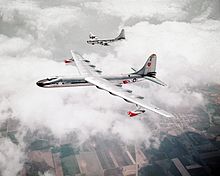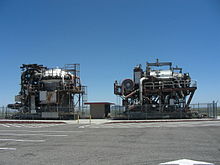- Nuclear aircraft
-
This article is about Aircraft nuclear propulsion. For the US Air Force program, see Aircraft Nuclear Propulsion. For the crystallographic feature known as an atomic plane, see crystallography.
A nuclear aircraft is an aircraft powered by nuclear energy. Research into them was pursued during the Cold War by the United States and the Soviet Union as they would presumably allow a country to keep nuclear bombers in the air for extremely long periods of time, a useful tactic for nuclear deterrence. Neither country created any nuclear aircraft in production numbers. One design problem, never adequately solved, was the need for heavy shielding to protect the crew from radiation sickness. Since the advent of ICBMs in the 60s the tactical advantage of such aircraft was greatly diminished and respective projects were cancelled. Because the technology was inherently dangerous it was not considered in non-military contexts.
Unmanned missiles have been designed to use nuclear thermal rockets, but such designs were considered too dangerous for crews to fly.
 The only US aircraft to carry a nuclear reactor was the NB-36H. The program was canceled in 1958
The only US aircraft to carry a nuclear reactor was the NB-36H. The program was canceled in 1958
Contents
U.S. programs
NEPA and ANP
Main article: Aircraft Nuclear PropulsionIn May 1946, the Nuclear Energy for the Propulsion of Aircraft (NEPA) project was started by the United States Air Force. Studies under this program were done until May, 1951 when NEPA was replaced by the Aircraft Nuclear Propulsion (ANP) program. The ANP program included provisions for studying two different types of nuclear-powered jet engines, General Electric's Direct Air Cycle and Pratt & Whitney's Indirect Air Cycle. ANP also contained plans for two B-36s to be modified by Convair under the MX-1589 project, one of the B-36s was to be used to study shielding requirements for an airborne reactor while the other was to be the X-6. The program was cancelled before the X-6 was completed, however.
The first operation of an aircraft engine on nuclear-power was achieved on January 31, 1956 using a modified General Electric J47 turbojet engine.[1] The Aircraft Nuclear Propulsion program was terminated following the President's annual budget message to Congress in 1961.
The Oak Ridge National Laboratory conducted research (Aircraft Reactor Experiment) to produce a nuclear powered aircraft. Two General Electric turbofan engines were successfully powered to nearly full thrust using two shielded reactors. The two engines complete with reactor system are currently located at the EBR-1 facility south of the Idaho National Laboratory.
The U.S. designed these engines to be used in a new specially designed nuclear bomber, the WS-125, which was eventually terminated by Eisenhower who cut NEPA and told Congress that there was no urgency for the program. Eisenhower did back a small scale program developing high temperature materials and high performance reactors. That program was terminated early in the Kennedy administration.
Project Pluto
Main article: Project PlutoIn 1957, the Air Force and the U.S. Atomic Energy Commission contracted with the Lawrence Radiation Laboratory to study the feasibility of applying heat from nuclear reactors to ramjet engines. This research became known as Project Pluto. The engines being developed under this program were intended to power an unmanned cruise missile, called SLAM, for Supersonic Low Altitude Missile. The program succeeded in producing two test engines which were operated on the ground. On May 14, 1961, the world's first nuclear ramjet engine, "Tory-IIA," mounted on a railroad car, roared to life for just a few seconds. On July 1, 1964, seven years and six months after it was born, "Project Pluto" was cancelled.
Soviet programs
Soviet Nuclear Bomber hoax
The 1 December 1958 issue of Aviation Week included an article, Soviets Flight Testing Nuclear Bomber, that claimed that the Soviets had made great progress in their own nuclear aircraft program.[2] This was accompanied by an editorial on the topic as well. The magazine claimed that the aircraft was real beyond a doubt, stating that "A nuclear-powered bomber is being flight tested in the Soviet Union. Completed about six months ago, this aircraft has been flying in the Moscow area for at least two months. It has been observed both in flight and on the ground by a wide variety of foreign observers from Communist and non-Communist countries." Unlike the US designs of the same era, which were purely experimental, the article noted that "The Soviet aircraft is a prototype of a design to perform a military mission as a continuous airborne alert warning system and missile launching platform."
Photographs illustrated the article, along with technical diagrams on the proposed layout. They were so widely seen that one company produced a plastic model aircraft,[3] a surprisingly faithful rendition of the diagrams in the article.
Concerns were soon expressed in Washington that "the Russians were from three to five years ahead of the US in the field of atomic aircraft engines and that they would move even further ahead unless the US pressed forward with its own program".[4] This led to continued funding of the US's own program, for a time.
In reality the entire article was a hoax. The aircraft in the photographs was later revealed to be the entirely conventional Myasishchev M-50 Bounder, a medium-range strategic bomber with performance similar to the USAFs B-58 Hustler. The design was considered a failure and never entered service. The design was revealed to the public on Soviet Aviation Day in 1963 at Monino, putting the issue to rest.[5]
Tupolev Tu-119
The Soviet program of developing nuclear aircraft resulted in the experimental Tupolev Tu-119, also known as the Tu-95LAL (LAL- Летающая Атомная Лаборатория- Flying Nuclear Laboratory). It was based on a Tupolev Tu-95 bomber. It had 4 conventional turboprop engines and an onboard nuclear reactor. The Tu-119 completed 34 research flights. Most of these were made with the reactor shut down. The main purpose of the flight phase was examining the effectiveness of the radiation shielding which was one of the main concerns for the engineers. Massive amounts of protection used resulted in radiation levels low enough to consider continuing development. But, as in the US, development never continued past this point. The obvious potential of the ICBM made the expensive program superfluous, and around the mid 1960s it was cancelled.
Several other projects reached only design phase.[6]
See also
- Georgia Nuclear Aircraft Laboratory
- Aircraft Nuclear Propulsion Project
- Induced gamma emission speculated as power source for aircraft
References
- ^ Thornton, G.. "Introduction to nuclear propulsion- introduc- tion and background lecture 1, feb. 26-28, 1963". Nuclear Materials Propulsion Operation. NASA Technical Report Server. http://hdl.handle.net/2060/19640019868. Retrieved 21 September 2011.
- ^ Soviets Flight Testing Nuclear Bomber, Aviation Week, 1 December 1958, p. 27.
- ^ AURORA 128 Russian Nuclear Bomber (1959)
- ^ Soviet Nuclear Plane Possibility Conceded, Ford Eastman, Aviation Week, 19 January 1959, p. 29.
- ^ AURORA Russian Nuclear Bomber : the Sources
- ^ Soviet Experimentation with Nuclear Powered Bombers by Raul Colon.
External links
- News article on the future of nuclear airplanes
- Short overview of the NB-36 programme
- Molten salt reactor experiment (initially intended for aircraft propulsion)
- Descriptions of the Tu-95 experiment: [1] [2] (in Russian)
- The Decay of the Atomic Powered Aircraft Program, retrieved 2009 Dec 21, includes a bibliography
- Flying on Nuclear, The American Effort to Built a Nuclear Powered Bomber by Raul Colon , retrieved 2009 Dec 21
- "A Scientist Preview The First Atomic Airplane" by Gerald Wendt for 1951 a very good article with illustrations on the subject of using an atomic reactor to power an aircraft
Nuclear propulsion Spacecraft Antimatter catalyzed nuclear pulse propulsion · Bussard ramjet · Fission-fragment rocket · Fission sail · Fusion rocket · Gas core reactor rocket · Nuclear electric rocket · Nuclear photonic rocket · Nuclear pulse propulsion · Nuclear salt-water rocket · Nuclear thermal rocket · Radioisotope rocket · Project OrionSea vessels Aircraft Nuclear aircraft · Aircraft Nuclear Propulsion program · Convair X-6 · Tupolev Tu-119 · Project PlutoGround Categories:- Nuclear vehicle propulsion
- Nuclear-powered aircraft
Wikimedia Foundation. 2010.

